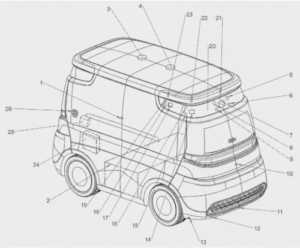Ekin, a tech company from Istanbul, Turkey, has a newly published patent application for a self-driving police car controlled by AI, capable of enforcing traffic laws and identifying suspicious people without an officer in tow.

Illustration of an autonomous patrol vehicle with its surveillance and detection systems.
The patrol car described in the document is 2.65 meters long, 1.65 meters high, and 1.3 meters wide. This means it would occupy about half the space a typical sedan does. Futurists like to envision roads with compact cars, which offer greater efficiency and maneuverability in dense cities. Ekin says its autonomous vehicles are small enough to be carried on a light truck/transporter as needed. The cars may also be moved or parked on the side of a road or even a large pavement area.
Each vehicle would be able to self-navigate with the assistance of a GPS or similar positioning system. They would take predetermined routes and/or visit locations at predetermined times—close to a school during class hours, for example. This includes traveling to a fast-charging base to replenish batteries that could power a car for weeks at a time. This will be easier as times go by as charging stations are cropping up across North America at an accelerating pace, keeping up with the mass adoption of electric vehicles for both economic and environmental reasons.
Ekin’s invention may carry out patrolling duties through an onboard surveillance and detection system, which could include cameras, sensors, radar, and lidar. At least one video camera paired with a microphone would enable the autonomous vehicle to detect sights and sounds in a 360-degree radius while it is parked or in motion. Data gathered in real-time can be sent to a command control center, likely for examination by a human operator.
The patent application cites the reliability and efficiency drawbacks of manned patrol vehicles, whose officers are bound to suffer from fatigue as their shift goes on and weariness from beats that are either too hectic or too uneventful. There is also the complicated issue of police brutality brought on by anything from judgment lapses to hateful biases. By employing neutral artificial intelligence, policing may become less discriminatory and safer for everyone involved. The same line of thinking is already being explored for the human workforce in general.
Ekin suggested that its patrol car can recognize faces, animals, and objects such as license plates or guns. It attempts to match this information to those in a security database, which may include missing persons or vehicles, as well as wanted criminals. The system comes with a positioning device that helps it capture images of persons and items.
The patrol car could come equipped with additional smart sensors to measure air quality and threatening radiation levels, among others. Sound sensors enable the system to listen for suspicious or dangerous sounds like a gunshot. Its threat detection capabilities may also extend to recognizing abnormal behavior, opening the possibility of detecting a crime before it happens.
But policing does not entirely revolve around violent crime; cops pull over more than 20 million motorists every year for traffic violations, according to the Stanford Open Policing Project. This makes traffic stops a common point of contact between law officers and the public. Ekin claims its patrol car is capable of detecting traffic violations as well as gathering license plate and vehicle information, which are then sent to a central database.
The vehicle sends automated alarms to first responders, such as police officers or paramedics. It can be an alert for a crime or accident that may include a live video feed accompanied by two-way audio. Essential first aid equipment may be loaded onto the patrol car for first responders to use upon arrival. They may also be briefed on the situation based on data gathered by the vehicle at the scene.
The patent application also mentions how an automated patrol car can serve as a platform for drones: staple tools in modern U.S. policing that may also be subject to AI integration in the future. Drones have become a more convenient alternative to the police helicopter, and can augment the Ekin vehicle’s surveillance capabilities while offering aerial functionalities like chasing a suspect or searching for individuals in wreckage.
Ekin says its driverless patrol car can help protect smart cities, though it is not the only company looking to populate the roads of the future with AI-powered machines. From taxis to trucks, the entrustment of the steering wheel to computers appears to be the common solution to the age-old issues humans tend to cause in urban areas and beyond.
The featured patent application, “Battery Powered Artificial Intelligence Autonomous Patrol Vehicle”, was filed with the USPTO on January 31, 2020 and published thereafter on August 5, 2021. The listed applicant is Ekin Teknoloji Sanayi ve Ticaret Anonim Sirketi. The listed inventor is Akif Ekin.


